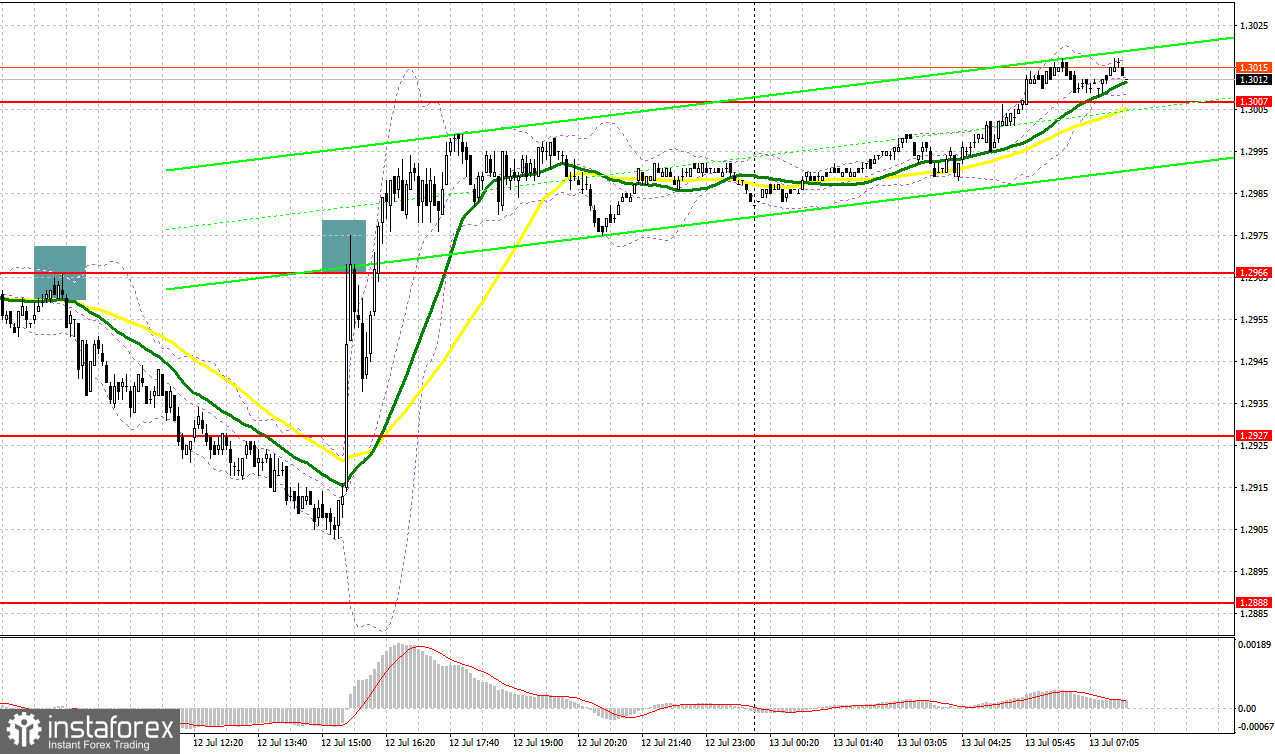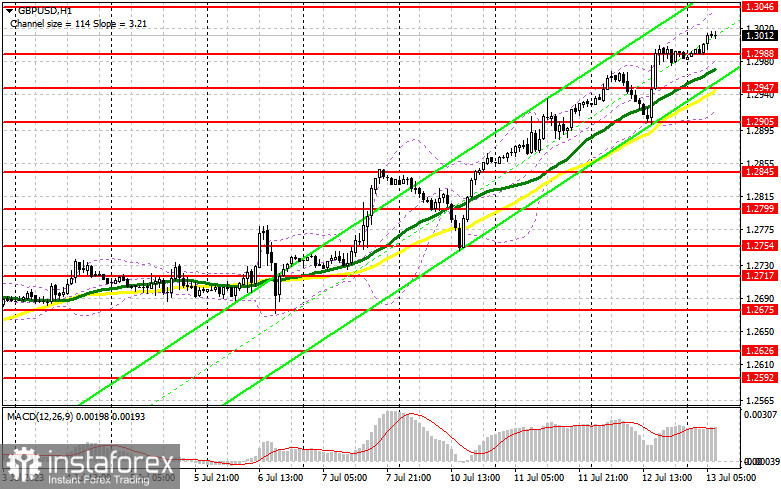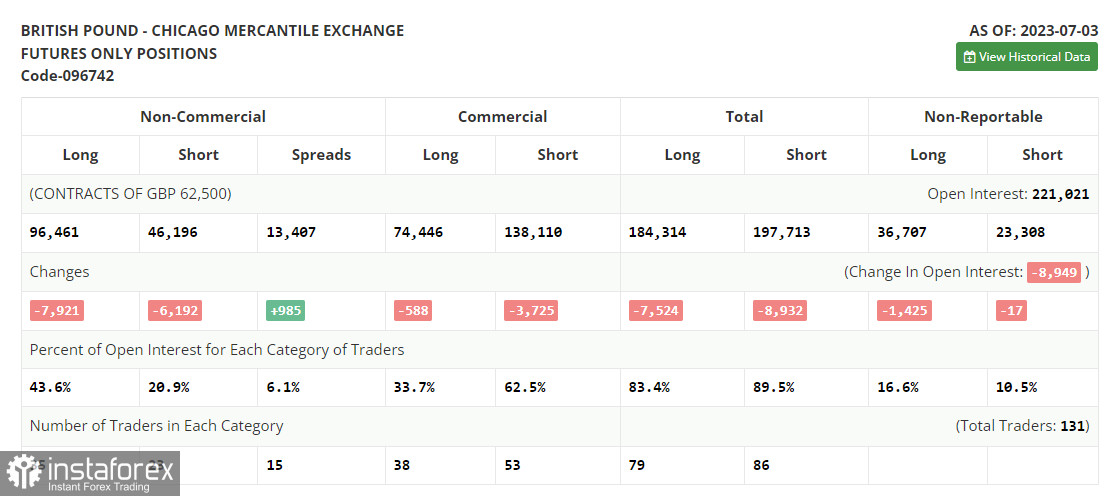Yesterday, there were several entry points. Now let's look at the 5-minute chart and try to figure out what actually happened. Previously, I considered entering the market from the level of 1.2966. A rise and false breakout on this mark produced a sell signal. As a result, the pair fell by more than 60 pips. In the second half of the day, a similar false breakout at this mark also gave a sell signal, but after falling by 25 pips, the pound was in demand once again.

For long positions on GBP/USD:
Cooling US inflation data made it possible for the pound to extend its upward movement against the US dollar, which has been becoming increasingly difficult for the bulls. Given the highs we are at, only an impressive UK GDP report for May will allow the pound to strengthen further. Considering that the data is expected to be quite bad, it's best not to rush into long positions. In addition to the GDP, figures on the volume of industrial production and the UK's service sector activity index will also be released.
One should go long on the decline from the nearest support level of 1.2988, formed yesterday. A false breakout will indicate the presence of large buyers in the market. It could trigger a buy signal. GBP/USD may climb to the resistance level of 1.3046. A breakout and consolidation above this level on the back of strong GDP will provide an additional buy signal with a rise to 1.3072. A more distant target will be the 1.3097 level where I recommend locking in profits.
If the pair declines to 1.2988 and bulls show no activity at this level, and the pair has been long overdue for a correction, the pair will hardly be able to grow higher. In this case, only the protection of 1.2947 where the moving averages are passing, as well as a false breakout will create new entry points into long positions. You could buy GBP/USD at a bounce from 1.2905, keeping in mind an upward intraday correction of 30-35 pips.
For short positions on GBP/USD:
The bears are unable to regain control. In the first half of the day, only disappointing UK data may be able to limit the pair's potential for further growth. The main task for today will be the protection of the resistance level of 1.3046. They could also try to return the pair to the support level of 1.2988. If the pair grows, a false breakout of 1.3046 will give an excellent sell signal, which could increase pressure on GBP/USD, with the goal of updating 1.2988, the support level that was formed yesterday. A breakout and an upward retest will undermine bullish sentiment, pushing GBP/USD to 1.2947. A more distant target will be the low of 1.2905 where I recommend locking in profits.

If GBP/USD advances and bears fail to defend 1.3046, bulls will continue to control the market. In this case, I would advise you to postpone short positions until a test of the resistance level of 1.3072. A false breakout there will generate an entry point into short positions. If there is no downward movement there, you could sell the pound sterling at a bounce from 1.3097, keeping in mind a downward intraday correction of 30-35 pips.
COT report:
The COT report from July 3 logged a decrease in both long and short positions. Buyers will likely be aggressive due to the hawkish Bank of England. The regulator prefers to keep interest rates high despite all the pressure and economic issues because inflation remains persistent, affecting the welfare of households. No matter what the Fed's policymakers say, traders are now betting on a weaker US dollar in the medium term. This is due to the nearly-peaking interest rates in the US. Therefore, buying the pound during falls remains an optimal trading strategy. According to the latest COT report, short non-commercial positions dropped by 6.192 to 46,196, while long non-commercial positions fell by 7,921 to 96,461. The total non-commercial net position edged down to 50,265 versus 51,994 a week earlier. The weekly closing price declined to 1.2698 from 1.2735.

Indicator signals:
Moving Averages
Trading is carried out above the 30-day and 50-day moving averages, which indicates a further rise.
Note: The period and prices of moving averages are considered by the author on the one-hour chart that differs from the general definition of the classic daily moving averages on the daily chart.
Bollinger Bands
If GBP/USD declines, the indicator's lower border near 1.2925 will serve as support.
Description of indicators:
• A moving average of a 50-day period determines the current trend by smoothing volatility and noise; marked in yellow on the chart;
• A moving average of a 30-day period determines the current trend by smoothing volatility and noise; marked in green on the chart;
• MACD Indicator (Moving Average Convergence/Divergence) Fast EMA with a 12-day period; Slow EMA with a 26-day period. SMA with a 9-day period;
• Bollinger Bands: 20-day period;
• Non-commercial traders are speculators such as individual traders, hedge funds, and large institutions who use the futures market for speculative purposes and meet certain requirements;
• Long non-commercial positions represent the total number of long positions opened by non-commercial traders;
• Short non-commercial positions represent the total number of short positions opened by non-commercial traders;
• The non-commercial net position is the difference between short and long positions of non-commercial traders.





















